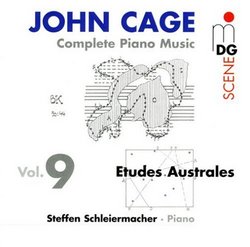| All Artists: John Cage, Steffen Schleiermacher Title: Cage: Complete Piano Music, Vol. 9: Etudes Australes Members Wishing: 1 Total Copies: 0 Label: MD&G Records Release Date: 9/24/2002 Genre: Classical Styles: Chamber Music, Historical Periods, Classical (c.1770-1830) Number of Discs: 3 SwapaCD Credits: 3 UPC: 760623079523 |
Search - John Cage, Steffen Schleiermacher :: Cage: Complete Piano Music, Vol. 9: Etudes Australes
 | John Cage, Steffen Schleiermacher Cage: Complete Piano Music, Vol. 9: Etudes Australes Genre: Classical |
Larger Image |
CD Details |
CD ReviewsSchleiermacher does it again! Tom Furgas | Youngstown, OH United States | 01/28/2004 (5 out of 5 stars) "Steffen Schleiermacher has proven to be the best in the new breed of Cage piano intepreter. The greatest difficulties of Cage's piano writing seem to be mere trifles under the hands of this incredible pianist. Of special note in this recording of the "Etudes Australes" is the fact that Schleiermacher consulted with Grete Sultan, the work's dedicatee, on interpretation and form. Although they did not see eye to eye on every detail, there was generally mutual agreement on the best way to interpret this work. The recording is clean, clear, and beautiful from beginning to end. For any Cage enthusiast it is certainly a must! For that matter, anyone interested in 20th century piano music should have this recording in their collection, as it is every bit as beautiful and authentic as the Wergo recording by Sultan herself." Etudes,"Etudes" Genres and Objectivities scarecrow | Chicago, Illinois United States | 01/27/2005 (5 out of 5 stars) "Etudes Australes are thirty-two etudes divided into four books, each book having eight etudes, the title, as you may know is from the "Atlas Australis" a book of star maps which served to inspire the multiplicities, distributive arrays of intervallic configurations here. I recall the Grete Sultan first recording, the vinyl recording the album cover actually won a prize. This was a cover where the rubber wedges (Cage suggests utilzing to help keep certain resonant tones depressed, they are wedged between the white keys,and then removed after the pianist progresses to subsequent books, like a fixity of timbral resonance assured, like the stars in the sky, how we come to depend on their mysteries, or beauty), these rubber wedges were placed over the exquisite looking star-maps in colours, green reds, and blues.
The pianist has much responsibility here, since neither tempi nor dynamics,nor articulation,nor gesture, nor momentum,nor image,nor rhythm,nor import are indicated in the music. You havesimply unbeamed notes, black and open like the stars from the map, then you have open notes that Cage says are simply "held for a long time", Each note then has its own "freedom" its own time so quite literally the metronome marking could change incessantly, relentlessly for each note. This openended-ness is I think the point of the concept of "etude" for one could quite literally devote a better portion of ones life playing and realizing the infinite performative possibilities implied here. The music however (Cage advises), should sound as it looks, meaning that the pianist should make every effort to play the work aside from the tempi indulgences not indicated, so freedom is in the end has a practical horizon, I think Cage in his anarchist utopian demeanor, wants one to think in terms of infinites,that's nice and proper and isn't it boring and tedious then when the real, reality of the globe hits the artist we are sent backwards to what the mind already knows, said Jasper Johns someplace. So these etudes can in fact be played with a high degree of beauty, and I think that is the problem with many pianists here that they are afraid of beuaty sometimes, or it simply happens anyway (especially in Cage's music) so why fret about it needlessly. I think fo these "etudes" while listening as wind-chimes, simply timbres in the breezes." |
